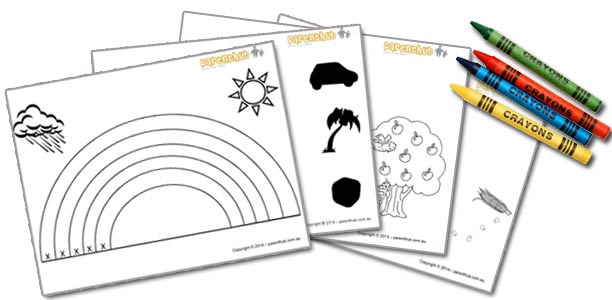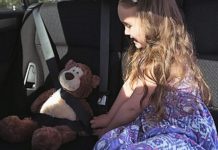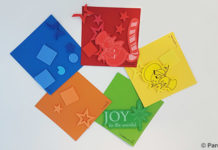Age
2-4 years
Duration of activity
You can fill in ten spare minutes doing one of these worksheets with your toddler. If you have a longer period of time you could spend an hour or so doing all of the activity sheets.
Materials/equipment
- Follow the line activity sheets
- Textas, crayons and/or pencils
- Laminating pouches (optional)
Cost
You can print multiple copies of the worksheets for less than $1. If you don’t already have textas and crayons in your child’s make and do box, you should be able to buy them for less than $5.
If you choose to laminate the worksheets so your child can reuse them many times, you’ll spend a couple of dollars extra but your worksheets will last much longer. Use washable markers on them and then just use some water or a baby wipe to clean them.
Preparation
Print the worksheets and put textas or crayons at a table or other flat surface where your child will do the drawing.
What to do
Activity 1: Follow the lines of the rainbow worksheet
 To do this activity your child needs to fill in the colours of the rainbow, by drawing a line from left to right between each pair of rainbow lines with a thick texta or crayon.
To do this activity your child needs to fill in the colours of the rainbow, by drawing a line from left to right between each pair of rainbow lines with a thick texta or crayon.- Show your child the rainbow activity sheets and have a chat about rainbows. For example, you could ask them to name different colours they see in rainbows, talk about where they see rainbows and how they are formed.
- Tell your child that today you will make the rainbow on the activity sheet colourful like a real rainbow. Explain that you will do that by drawing coloured lines from left to right on the rainbow.
- Show your child the X that marks the starting point on the left side of the rainbow and explain this is where they need to start writing each coloured line.
- Tell your child that the start mark is on the left hand side of the page and that the other side of the page is the right hand side. Spend a few minutes discussing left and right, for example explain to your child that everything, including our bodies, has a left and a right side. If they are already becoming familiar with left and right, you might ask them to show you their left and then their right hand.
- Explain to your child that soon they will be learning to write words like their name and that English words are always written starting from the left hand side and going to the right hand side.
- Ask your child to draw between two of the lines on the rainbow with their finger, starting at the mark on the left and following the space between the lines to the right.
- Now ask them to take a thick texta (if you don’t have textas use a fat crayon) and draw a coloured line between the first two lines of the rainbow. Remind them to start at the left and draw towards the right. Encourage them to take care and stay between the lines.
- Repeat for other lines of the rainbow, using a different colour for each.
- When they have finished drawing the coloured lines, get them to point to each colour and name it.
- Ask your child to count all the different colours they see on the rainbow.
Activity 2: Help the chicken find the corn worksheet
 To do this activity your child needs to draw a line from the chicken on the left hand side of the page to the cob of corn on the right hand side of the page. The line should run through each of the kernels of corn scattered on the page, but always go in the left-right direction- the line cannot go backwards to pick up pieces of corn that were skipped along the way.
To do this activity your child needs to draw a line from the chicken on the left hand side of the page to the cob of corn on the right hand side of the page. The line should run through each of the kernels of corn scattered on the page, but always go in the left-right direction- the line cannot go backwards to pick up pieces of corn that were skipped along the way.- Show your child the worksheet and get them to talk about what they see. Ask questions to encourage them to keep talking, for example ask your child questions about the size of the objects on the page or the things they like and dislike.
- Explain to them that the chicken in the worksheet has lost its corn and their task is to help the chicken find the cob of corn and all the corn kernels which have fallen off it. Ask your child to point to all the corn kernels and count them.
- Tell your child that to help the chicken find its corn they must draw a line from the chicken to the corn and that the line must also pass all the corn kernels.
- Tell them that the line must start at the chicken which is on the left hand side of the page. Explain to them that when we write in English we always start writing from the left hand side of the page and go to the right hand side and that drawing these lines will help them learn to write words properly.
- Discuss left and right for a minute. For example you could explain that every object has a right and a left side and ask them to point to the left and right side of the paper.
- Next get them to use their finger to draw a line from the chicken to the corn kernels and the cob of corn. Correct them if they make a mistake, for example if they start drawing the line from the cob on the right hand side or if they skip kernels of corn.
- Now get them to select a pencil or texta and draw the line on the paper. Help them along the way, for example remind them of the correct place to start and to go over every corn kernel on the page.
Activity 3: Draw the snake’s zigzag pattern worksheet
 This activity involves your child drawing between the zigzag line on the snake from left to right to give the snake a coloured pattern.
This activity involves your child drawing between the zigzag line on the snake from left to right to give the snake a coloured pattern.- Show your child the worksheet and ask them what they see and talk about snakes for example their size, colour and where they like to live.
- Tell your child that the snake on the worksheet is unhappy because it has lost the beautiful colour on its zigzag pattern. Your child can help by drawing a coloured line inside the zigzag pattern on the snake’s back.
- Explain to your child that you will draw the zigzag pattern in the same direction as words are written, starting at the left and moving to the right hand side of the page. Tell them that as they draw the zigzags they must be very careful not to go outside the lines of the zigzag, or the pattern will end up all over the grass instead of on the snake’s back.
- Talk about left and right and explain that English words and sentences are always written starting at the left hand side of the page and moving to the right hand side. Tell them that in some other languages with different alphabets that writing starts at the right and goes to the left.
- Ask your child to point to the left hand side of the snake where the starting mark is. Then get them to draw a zigzag line using their finger.
- Next get them to choose a pencil and write the zigzag line on the snake with the pencil. Remind them to start at the left hand side of the page as if they are writing, and fill in the zigzags.
- When they have drawn the line they may like to colour in the rest of the worksheet.
Activity 4: Help the bird find its nest worksheet
 This activity involves your child drawing a swirly line to help the bird find its nest.
This activity involves your child drawing a swirly line to help the bird find its nest.- Show your child the worksheet and ask them to talk about what they see. Ask them questions to encourage them to talk more, for example you could ask how many wings the bird has or what the bird makes a nest for.
- Next explain to your child that this bird has lost its nest and their job is to help it find its way back. To do that they need to trace over the swirly line, starting at the bird on the left of the page and going to the nest on the right hand side of the page. Explain that this is the same direction we use when writing English words.
- Spend a minute or two discussing left and right with your child. Depending on their age and ability they may be able to show you the left side of the paper or their body, but at this age it’s more likely you’ll need to show them and explain that everything has a left and a right hand side.
- Tell your child that when they trace the line they should start at the bird on the left hand side of the paper and draw towards the nest on the right hand side of the paper.
- Ask them to trace over the line with their finger. Remind them to start at the left hand side if they forget.
- Now get them to choose a texta or crayon and draw the trace line.
- When they’ve finished drawing, talk about the pattern and the shapes they can see in it.
Activity 5: Help the insects find their homes worksheet (Easy version | Challenge version)
 This activity involves tracing swirly lines to connect all the insects to their homes. There are two versions of this activity sheet- in the challenge version the lines cross over each other making it challenging for your child to see which line goes which way. Give your child the standard version first and only when they are able to trace those lines correctly give them the challenge. It will be difficult for most children at this age, but difficult challenges help kids develop and extend their abilities.
This activity involves tracing swirly lines to connect all the insects to their homes. There are two versions of this activity sheet- in the challenge version the lines cross over each other making it challenging for your child to see which line goes which way. Give your child the standard version first and only when they are able to trace those lines correctly give them the challenge. It will be difficult for most children at this age, but difficult challenges help kids develop and extend their abilities.- Show your child the activity sheet and explain to them that when the spider, worm and bee left home they walked on paths that curved around and crossed over each other. Now the insects are lost and can’t find their way home.
- Talk to your child about which home each insect lives in.
- Explain to your child that there are three lines on the page and their task is to trace over each one using a different colour so the animals can clearly see their paths and get back to their homes.
- Tell them that they must start drawing the lines on the left hand side of the page near the insects. The lines will move towards the right hand side of the page where the animal homes are.
- Explain to your child that this is the same direction we use when writing English words and sentences, so that doing this activity will help them learn to write.
- Ask your child to choose which insect they would like to help home first and point to the place they will start drawing that animal’s line home.
- Now ask them to trace the line using their finger. Remind your child that the lines cross over and they must be careful not to get on the wrong path at the cross over.
- When they have traced the line with their finger, ask them to choose a colour and trace the line.
- Repeat for the two other lines.
- When you have finished talk about the lines they have drawn, for example the shape, size and colour of each line.
Activity 6: Match the shape to its shadow
 This activity requires your child to draw a line diagonally from left to right to match each of the figures to its shadow.
This activity requires your child to draw a line diagonally from left to right to match each of the figures to its shadow.- Show your child the activity sheet and tell them that the figures on the left side of the page have lost their shadows and don’t know how to find them.
- Ask your child to point to and name each of the figures and talk a little bit about each one.
- Explain that your child can help by drawing a line to each of the shadows as a guide. Tell them that when they draw the lines they should start each line beside the figure on the left side of the page and draw towards the right side of the page. Explain that this is the same direction that words like their name and the words in their favourite book are written in.
- Ask them to point to each figure and then to its shadow and draw a line between them using their finger.
- Next get them to choose a colour and draw a line between one of the figures and its shadow. Ask them to draw the other lines using a different colour for each one.
- Your child may like to colour in the figures and shadows when they have finished the lines.
Tips
- Encourage your child to draw the lines without lifting their pen off the paper. Toddlers may not yet have the control to do this, for example they may stop and lift the pen for each zigzag or swirl, just as children typically lift their pen from the paper mid-letter when they’re learning to write.
- About half of all toddlers and most pre-schoolers will be showing a preference for either the left or the right hand. Encourage them to use their preferred hand when they are drawing the lines, but don’t be concerned if they swap hands from time to time- it’s perfectly normal.
- Each time your child takes a texta or crayon to start writing, spend a few seconds showing them the correct pencil grip, by holding your own texta. Help them rearrange their fingers into the correct grip so they get a feel for it. But don’t be concerned if they move their fingers when they start writing.
- Help toddlers draw the lines by placing your and over the top of theirs and guiding it from the left to the right side of the page.
- Stick the worksheets to a wall or easel and allow your child to complete them standing up with their arm raised up to their shoulder. This strengthens the shoulder and arms muscles that support the hand while writing.
Educational outcomes
Maths
This activity provides many opportunities for your child to develop their understanding of mathematical concepts including colour, pattern, direction, size and numbers.
Recognising colours and learning the names used to describe different colours are important mathematical skills that children develop very early in life. Toddlers will usually be able to match colours (e.g. put two red things together) but they probably won’t have mastered the names of colours just yet. For example, they might tell you that the two red objects they just matched are blue. But before long they’ll be able to name all the colours correctly and do things like count all the red objects or create patterns using a combination of colours (for example colour the v sections of the snakes zigzag in a red-yellow pattern).
Direction is another important mathematical concept. Without understanding left and right and other words that describe location and direction, it’s pretty hard to describe which way to go or where an object is located. As you work through these activities your child will probably also use lots of words to describe direction and location. For example they may tell you that the corn is far away from the chicken, the blue line of the rainbow is under the red line or that the lines to take the insects home run into each other.
Asking your child to talk about the size of the things they see on the worksheets is an easy way to help develop their understanding of size and their ability to describe an object’s size using mathematical language: words like big and small, tall and short and fat and thin. Toddlers will probably only be able to describe size using simple words like big and small. Preschoolers will have a broader mathematical vocabulary and will probably use a variety of words, for example by about three years of age most kids also understand short and long. Preschoolers may also be able to describe the relative size of objects using words like big, bigger, biggest.
As your child counts the colours of the rainbow or the kernels of corn, they’ll be developing their counting ability. Toddlers may only be able to count to two or three. Preschoolers will probably be able to count up to ten objects, but don’t be surprised if they skip to an odd number or get the sequence wrong (e.g. count 1,2,3,6,4) from time to time.
They’ll also develop awareness of important counting concepts including:
- One to one correspondence, that is, that every object has a quantity of one.
- Cardinality, that is, that when they are counting, the number they say when counting the last object reflects the total number of objects in a group.
- Place order, that is, that numbers are counted in sequence and each number has a place in that sequence (e.g. 5 always comes after 4 and before 6)
You could write numbers on the page next to each of the things they count, to help the understand how each quantity and number relates to numerals.
Fine motor
 Fine motor skills or the ability to control the fingers and use them to pick up and manipulate small objects like pens, book pages and beads are important for writing, self care and just about everything else. Everything your child does with their fingers depends on their fine motor skills. These skills begin to develop in infancy when babies start to touch, poke, rake and grasp objects and become more precise as children grow up.
Fine motor skills or the ability to control the fingers and use them to pick up and manipulate small objects like pens, book pages and beads are important for writing, self care and just about everything else. Everything your child does with their fingers depends on their fine motor skills. These skills begin to develop in infancy when babies start to touch, poke, rake and grasp objects and become more precise as children grow up.
Drawing and writing are fantastic ways for toddlers and pre-schoolers to develop their fine motor skills. They’ll be working the muscles they need to hold and manipulate a pencil each time they pick one up. Toddlers will probably still be using fist grip to hold the pencil, which as the name suggests means they will grip it with their entire fist (and move their entire arm, probably in jabbing motions, to make marks on the paper). They’ll look pretty clumsy but using the fist is an important first step in learning to grasp a pencil properly with the fingers. By about 3 years of age children have normally developed the ability to make marks with a pencil held between their fingers. However they’ll probably still rest the end of the pencil in their palm. This grip is commonly the second stage of learning to hold a pencil properly and is known as digital pronate grasp.
Reading and writing
English language writing always runs from left to right and drawing the lines in these worksheets from left to right is an important way for children who have not yet learnt to read or write words, to become aware of the direction of writing and reading. It’s similar to the way they develop awareness of this key print concept when you read a book and follow the text with your finger from left to right.
Social and communication skills
Socialising and communicating is the best way for children to develop these skills and as they socialise and communicate with you during this activity, they’ll be learning how to act in social situations and communicate effectively. That includes knowing the rules of interactions, things like taking turns to speak and asking and answering questions. They also be learning to communicate effectively. For example, they’ll learn new words to describe the things they want to tell you about. They experiment with combining those words in different ways to make sentences, as well as using body language, facial expression and tone of voice to add meaning to what they’re saying. They’ll get used to following instructions, initially one step at a time and later after hearing multiple steps at the same time.
Downloads
- Follow the lines of the rainbow worksheet
- Help the chicken find the corn worksheet
- Draw the snake’s zigzag pattern worksheet
- Help the bird find its nest worksheet
- Help the animals find their homes worksheet – easy version
- Help the animals find their homes worksheet – challenge version
- Match the shape to its shadow worksheet
References
- Virginia Early Childhood Development Alignment Program. Milestones of child development- A guide to young children’s learning and development from birth to kindergarten. 2009. (cited 26 July 2013). Available from: (URL Link)
- Queensland Health. Physical and cognitive milestones. 2007. (cited 31 July 2013). Available from: (URL Link)
- Jung M, Hartmen P, Smith T. The Effectiveness of Teaching Number Relationships in Preschool. Int J Instruction. 2013; 6(1). Available from: (URL Link)
- Community Childcare Cooperative Ltd (NSW). Development Milestones and the Early Years Learning Framework and the National Quality Standards. Australian Government Department of Education, Employment and Workplace Relations. 2012. (cited 5 May 2014). Available from: (URL Link)
- Andrews General Categories of Fine Motor Development. Michigan State University Extension. UNDATED. (cited 28 March 2014). Available from: (URL Link)
- Achorn LB, Wait KJ. The Relationship between Fine Motor Skills and Fluency of Handwriting in Kindergarten and First Grade Children. Paper presented to the Sage Colleges Program in Occupational Therapy. 2005. (cited 4 September 2014). Available from: (URL Link)
- South Carolina Education Office of Early Childhood Education. Good Start Grow Smart- South Carolina Early Learning Standards for 3, 4 and 5 year old children. 2007. (cited 17 November 2014) Available From: (URL Link)



 (10 votes, average: 4.60 out of 5)
(10 votes, average: 4.60 out of 5) 






